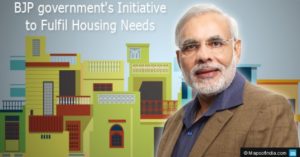PMAY was launched in June 2015. The Government envisages building affordable pucca houses with water facility, sanitation and electricity supply round-the-clock. The scheme originally was meant to cover people in the EWS (annual income not exceeding ₹3 lakh) and LIG (annual income not exceeding ₹6 lakh) sections, but now covers the mid-income group (MIG) as well.
PMAY scheme comprises of four key aspects. One, it aims to transform slum areas by building homes for slum dwellers in collaboration with private developers. Two, it plans to give a credit-linked subsidy to weaker and mid income sections on loans taken for new construction or renovation of existing homes.
An interest subsidy of 3 per cent to 6.5 per cent has been announced for loans ranging between ₹6 lakh and ₹12 lakh. For those in the EWS and LIG category who wish to take a loan of up to ₹6 lakh, there is an interest subsidy (concession) of 6.5 per cent for tenure of 15 years. So far around 20,000 people have availed of loans under this scheme. This month, the Government increased the loan amount to ₹12 lakh, targeting the mid-income category. The interest subsidy on loans upto ₹12 lakh will be 3 per cent. In rural areas, interest subvention of 3 per cent is offered on loans up to ₹2 lakh for constructing new homes or extension of old homes.
Three, the Government will chip in with financial assistance for affordable housing projects done in partnership with States/ Union Territories for the EWS. Four, it will extend direct financial assistance of ₹1.5 lakh to EWS.
Why is it important?
Today, while developers in India’s metropolitan cities are sitting on lakhs of unsold residences costing upwards of ₹50 lakh, the country is estimated to have a shortage of nearly 20 million housing units needed by the rural and urban poor, at far lower price points of ₹5-15 lakh. The PMAY aims to address this shortfall. With the increase in subsidised loan amount to ₹12 lakh, the scheme is expected to cover a higher proportion of the urban poor.
The PMAY will hopefully incentivise India’s construction and realty sector to reduce its traditional obsession with affluent home buyers in the cities.
Why should I care?
For those in the lower and mid-income groups, the PMAY reduces the cost of acquiring a home by ₹1lakh to ₹2.3 lakh. The increase in the loan amount to ₹12 lakh and extension of the scheme to mid-income group may make more homes within the reach of the urban poor. If you’re an investor, this scheme combined with a falling interest rate regime could mean improved loan growth for banks and NBFCs focussed on this segment. A pick up in demand for affordable housing will not only provide a leg up to the performance of banks and housing finance companies, but can also support growth of other allied businesses such as cement and steel.
The bottomline
Its time India’s realty majors followed the lead of their FMCG peers and took a look at the bottom of the pyramid.






